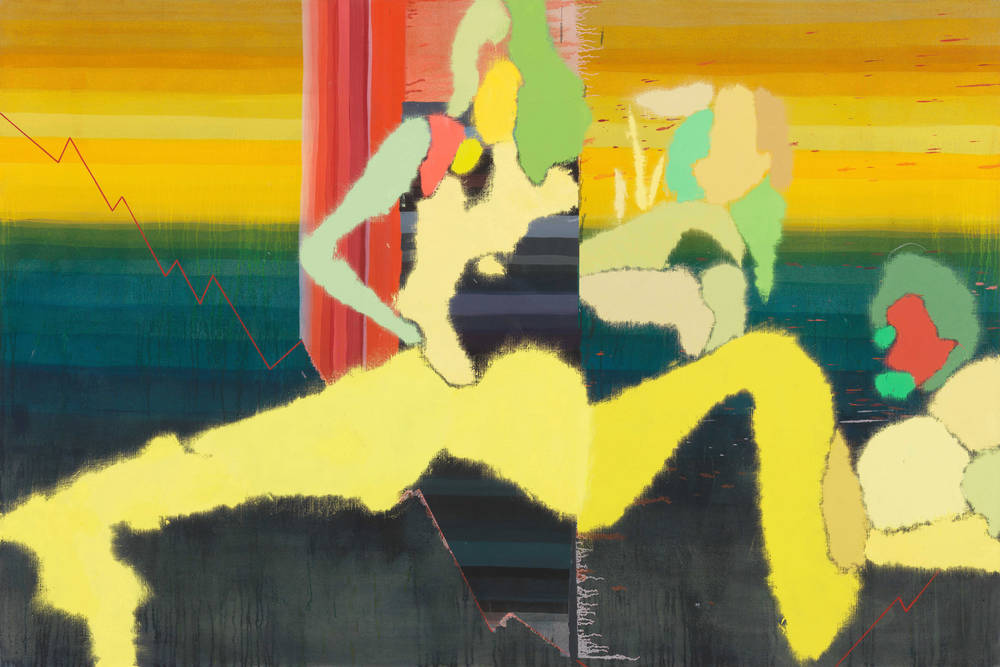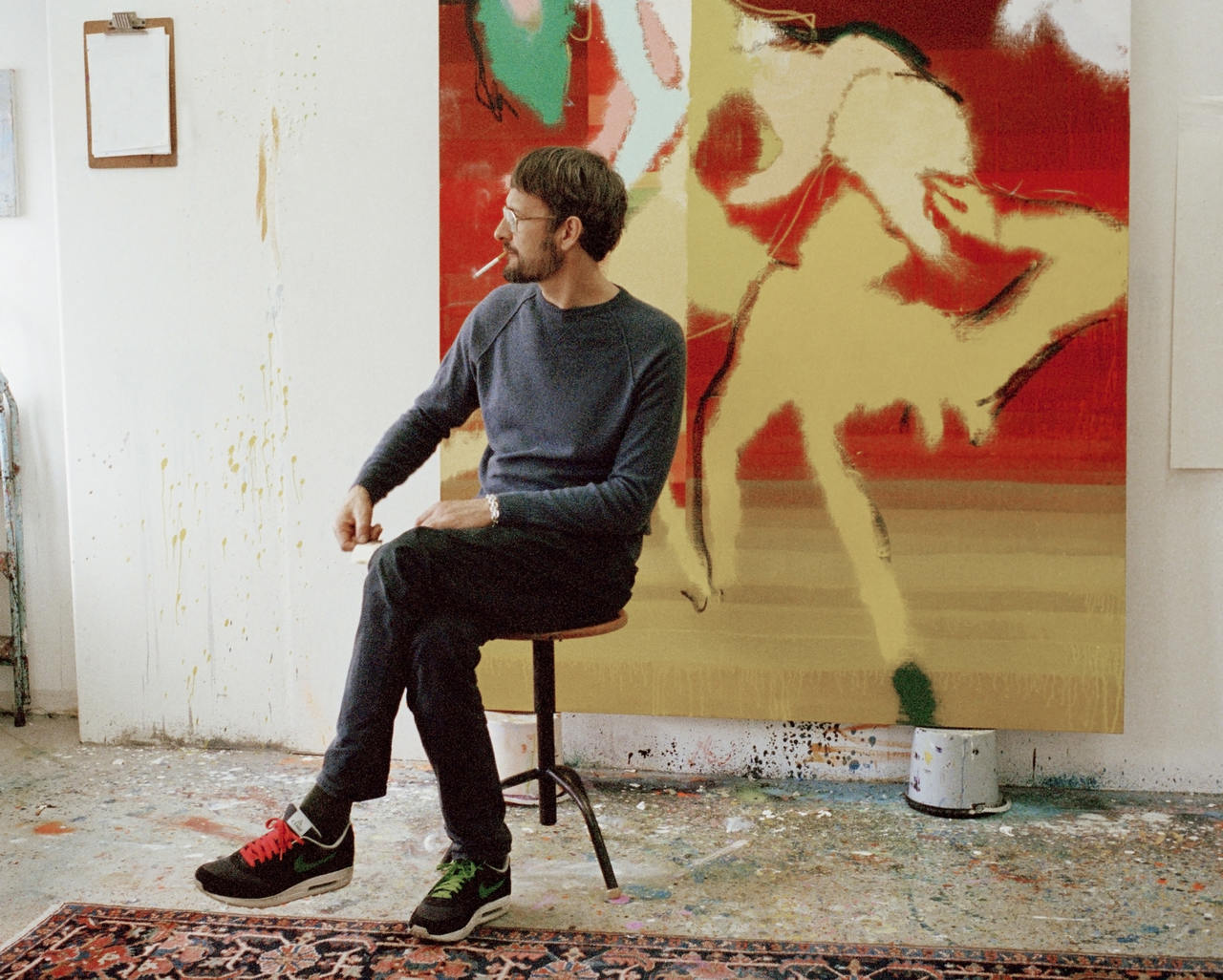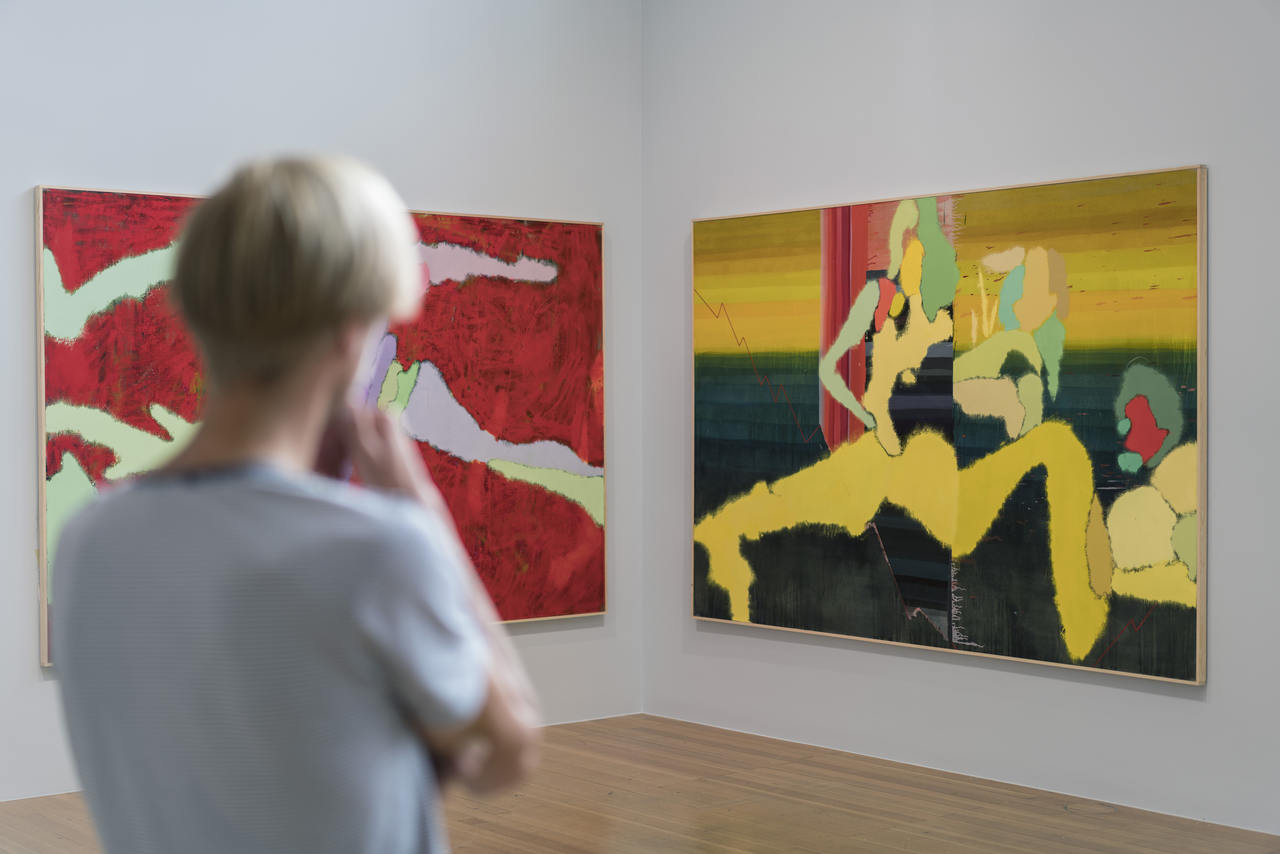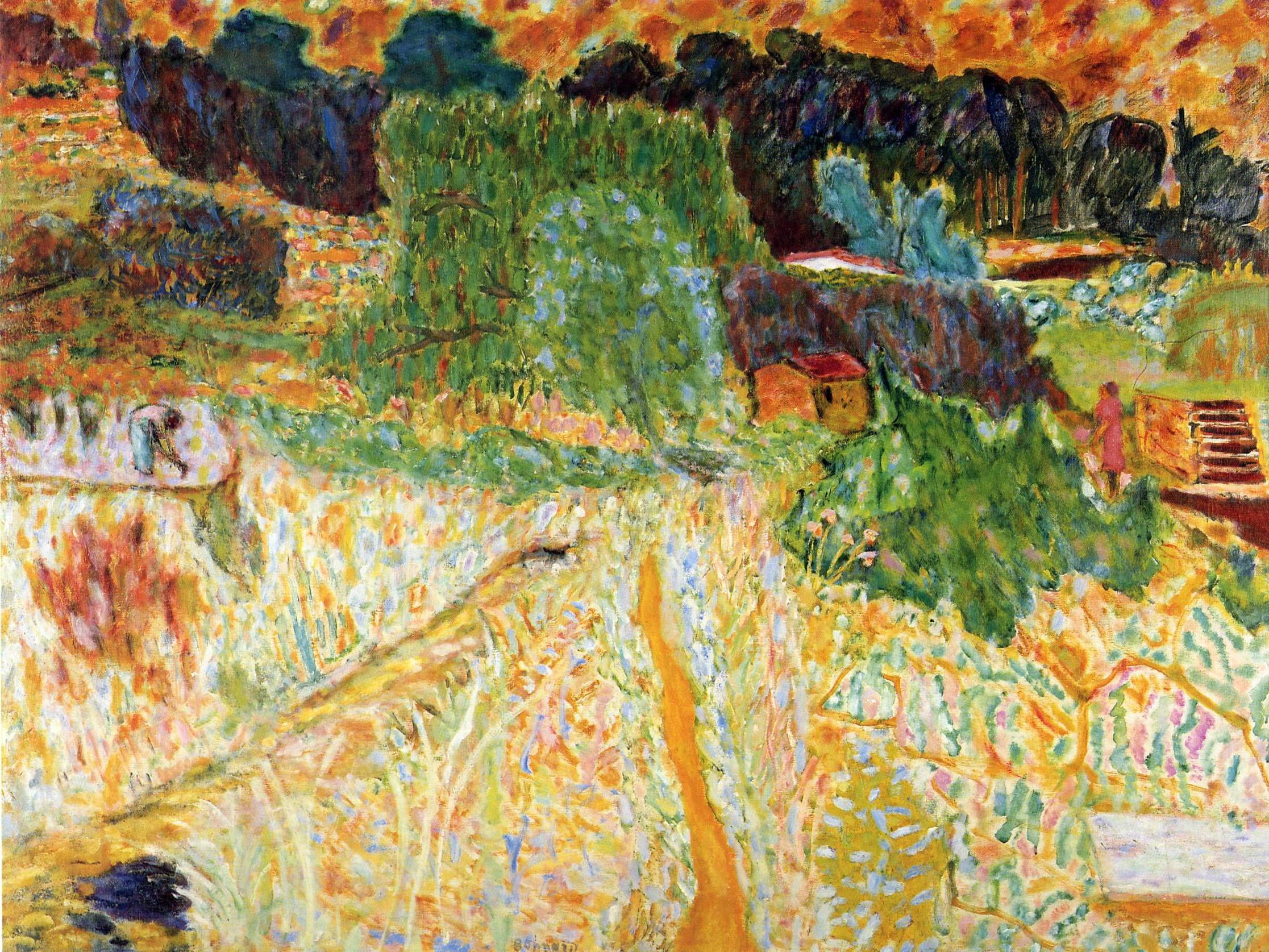Can the artistic development of painter Daniel Richter right up to his latest works in the SCHIRN be traced back to his teachers and thus divided into three phases? Let’s give it a try.
With the 22 new paintings he has put on display in the exhibition “Hello, I love you!” Daniel Richter has entered his third phase of creativity. Or at least that’s what we read in the arts supplements. The first phase was abstract, the second figurative, and the third turns again towards abstraction. When tracing the lines of such development in the work of a painter, one is inevitably confronted with the question of influences, the “pictorial roots”. So whence Daniel Richter’s path?
We can begin by tracing his path with the teacher generation, the painters working in Germany in the 1980s. This generation of so-called “New Wilds” or Neo-Expressionists combines an anarchic approach to form and content of painting with a propensity for large formats and energy-charged subjects. Their works are often described with buzzwords such as “fierce painting” or “bad painting”. One of their champions is Werner Büttner, who was Daniel Richter’s teacher at the University of Fine Arts in Hamburg. Indeed it was Büttner’s personal vote that secured Richter a place at the academy. He evidently saw something in the sketches Richter submitted for the entrance examination. According to Richter’s descriptions, these drawings were brimming with disrespect for established painter colleagues and explicit humour.
Since you all look like crappy old paintings
Büttner may well have been sympathetic towards this attitude, as reverence for painting traditions was hardly his style either. This is proven by picture series like Die Probleme des Minigolfs in der europäischen Malerei [“The problems of mini-golf in European painting”], which portray laughable mini-golf holes as serious subjects, or Badende Russen [“Bathing Russians”], which takes the traditional subject of bathers to the point of absurdity, as in these paintings bathers are nowhere to be seen, instead we see neatly folded military uniforms. Richter also loves this ironic-cryptic interplay of words and image. “Weil ihr alle ausseht wie alte beschissene Malerei, müssen Wir alle sterben” (“Since you all look like crappy old paintings, we all must die”), is the title of a painting from 2005, for example, in which we see a zombie-like mob of painters stalked by a fiery figure.
A second important point of reference for Daniel Richter during his student years was Albert Oehlen. He employed Richter as an assistant and so it follows logically that this role brought Richter into very direct contact with Oehlen’s pictorial ideas. Indeed it appears that Richter’s early paintings in particular were aesthetically related to Oehlen’s painting. Amorphous figures and faces or limbs imposed through collage protrude from tangles of colour only to disappear again. This interest in oscillation between figureation and abstraction links the works of both painters as much as does their love of organic forms and strong colors. Oehlen’s strategy of overstimulation through overload and superimposition is also reflected in Richter’s painting. When it comes to any and all parallels, however, Daniel Richter remarks that he sought to substitute Oehlen’s motto of “high art through low art” with his own “low art through high art”.
Somewhere between black Romanticism and Surrealist paranoia
What this might mean is a kind of simultaneous demonstration and deconstruction of refined painting technique, which is in contrast to the exhibited “brilliant dilettantism” so typical of the painting of the 1980s. This could at any rate prompt us to turn to the works of Richter’s second creative phase. It is now that Richter begins to explore the field of history painting, a genre with a long and weighty tradition. This gives rise to large-format, figurative paintings somewhere between black Romanticism and Surrealist paranoia, which make the painter a superstar. These works also testify to an expansion of his pool of pictorial points of reference.
When asked about his sources of inspiration, Richter never mentions representatives of classic history painting, but favors modern painters. A particular reference for him is the artistic group known as Les Nabis. A visit to the Musee d’Orsay in Paris aroused his interest in their painting. In actual fact, Richter’s works show pictorial parallels with the works of Félix Vallotton and Pierre Bonnard, particularly in the dissolution of the subject matter into ornamental structures and juxtaposed color fields, which meld to create a shimmering, image-filling whole. However, the shared pleasure in excess, in the frenzy of form and color cannot mask the few but clear differences. Richter is not interested in some “aestheticization” of the world to create a nostalgic feeling in the present. On the contrary, he uses this painting technique to design gloomy, nightmarish scenarios that appear much more indebted to the dream worlds of the Surrealists, and which achieve monumental dimensions – something that has only been conceivable in modern painting since the time of the Abstract Expressionists.
Oscillation between figuration and abstraction
With his new works at the Schirn, Richter noticeably reduces his range of themes and limits himself to just a few figures and pictorial elements against two-dimensional backgrounds. Richter himself says that he wanted a new direction and therefore tried out new techniques, such as working without brushes, using a spatula or chalk. Here the oscillation between figuration and abstraction remains a point of interest, as does the structuring of the pictorial space in terms of color fields. The familiar anarchic-ironic attitude and the sense for ambivalent pictorial content also continue to shine through, and leave no doubt about who is behind the painting. However, now a greater interest in formal questions of “painting as painting” comes to the fore. It therefore comes as no surprise that the painters of abstract post-war painting are now an important reference. His paintings Asger, Bill und Mark [“Asger, Bill and Mark”] and Francis der Fröhliche [“Francis the Merry”] can be considered as direct homages in this regards, (the references are probably to Asger Jorn, Bill Jensen and Mark Rothko, and to Francis Bacon), whereby Richter knows how to skillfully undermine their previously intolerable, existential seriousness with his Pop aesthetic.
What might now be the result of these observations? On the one hand, it appears that Richter takes great pleasure in playing around with the traditions of painting. Part of this game is hiding his references implicitly in the works, and part of it is indicating them explicitly. Here, he might remain thoroughly open about where he has taken his cue from works by other painters and where a similar approach to a question has led essentially by chance to a similar rendering of an image. It is most likely, as is so often the case, that both are true. On the other hand, attempting a synopsis of the cited pictorial “sparring partners” of Daniel Richter is promising. He wildly juxtaposes eras, techniques and questions of form and content. However, it quickly becomes clear that any search for faint tones or overly intellectual conceptualism is in vain. Rather, it is all about positions that drive a kind of “in-your-face” painting, a style of painting for which the current buzzwords used when describing paintings, such as “vibrant” or “emanating from the color” sound unpleasantly contrived. Anyone who sees the images at the SCHIRN will know immediately what that means.


Dinner is served: Daniel Richter as chef de cuisine
Artist Daniel Richter likes to use metaphors from the kitchen – SCHIRN MAGAZIN explains why he has prepared his new series of pictures at the SCHIRN...

Join the joyride – painting and music in the works of Daniel Richter
Can you translate music into painting and vice versa? Many artists, from Toulouse-Lautrec to Matisse to Yves Klein, have tried to do just that.
 Werner Büttner, Die Probleme des Minigolfs in der europäischen Malerei Nr. 4, 1982
Werner Büttner, Die Probleme des Minigolfs in der europäischen Malerei Nr. 4, 1982 Albert Oehlen, Evilution, 2002
Albert Oehlen, Evilution, 2002 Pierre Bonnard, Vue de l'atelier de l'artiste, 1945
Pierre Bonnard, Vue de l'atelier de l'artiste, 1945